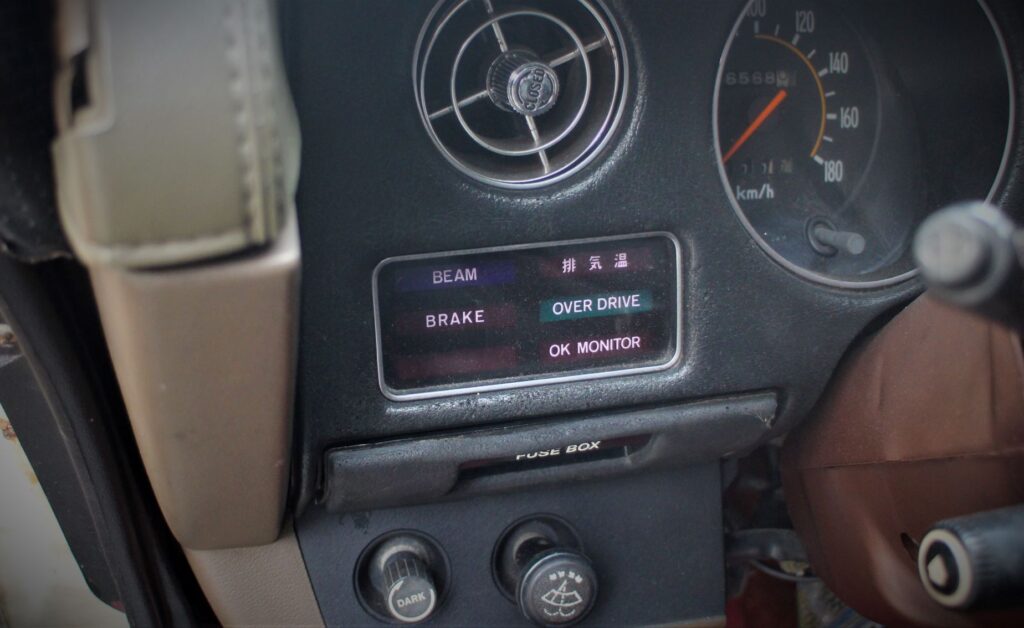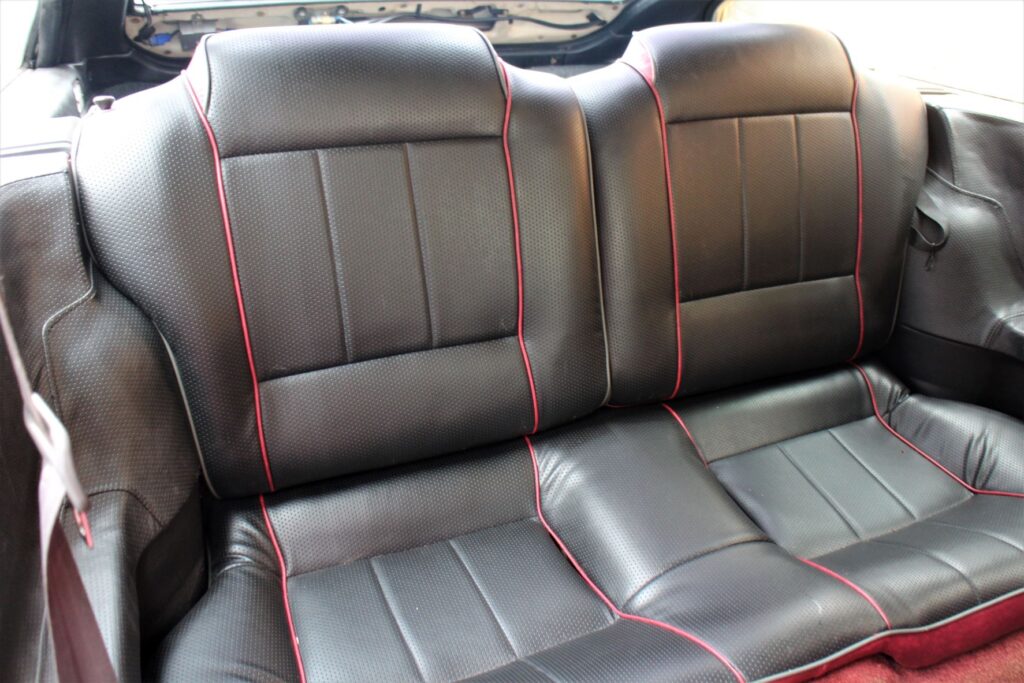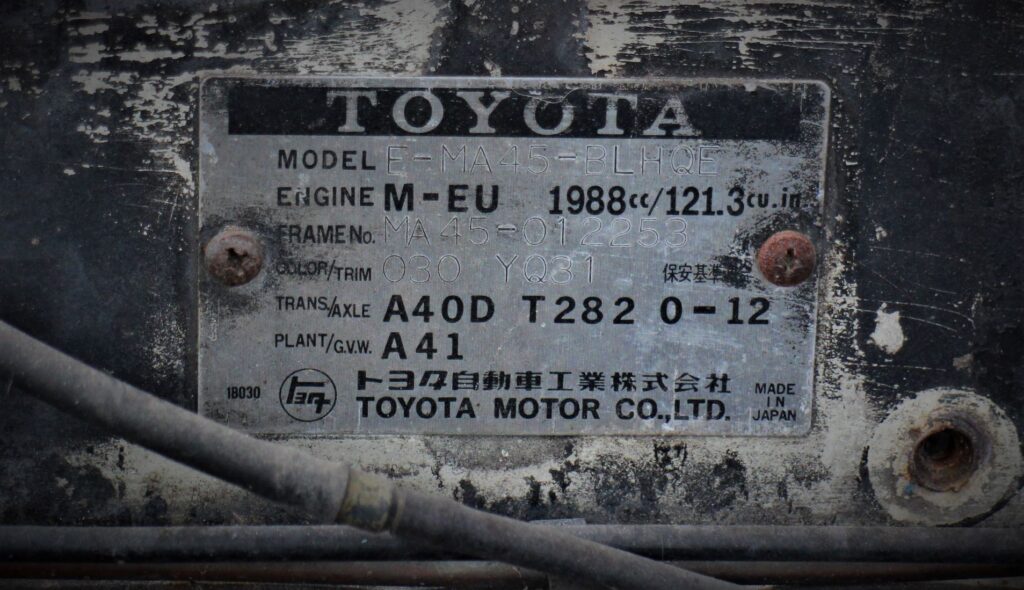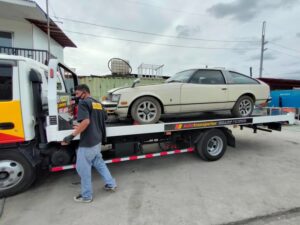In Part 1 of this Power Wheels Magazine Project Car series on our recently-acquired 1978 Toyota Celica XX Supra, we narrated how we found the car on Facebook Market Place and became intrigued with its low asking price that we were compelled to see it on December 19, 2021 despite the gloomy weather and holiday traffic. We saw that it was a Japanese domestic market (JDM) A45 Supra, a first-year, first-generation right-hand drive (RHD) grand tourer (GT) that was converted to left-hand drive (LHD) and fitted with a non-original Toyota 12R 4-cylinder engine and 5-speed manual transmission. We felt that it would make an interesting restoration project just to bring back its original drivetrain.
We closed a deal with the owner, Supra super enthusiast Edvilor “Ed” Ilano, Jr., and on the 28th, we took the car from Sucat, Parañaque to the JSK Custom Paint and Auto Works garage in Marulas, Valenzuela City on board an Auto Transporter flatbed carrier. We posted our latest acquisition here in the website and in our Facebook pages, and one of our friends, Norbie Sison, immediately commented that we seem to be on a buying spree of 6-cylinder project cars this year – having bought a 1995 Jaguar XJ6 (x300) in January and a 1990 Nissan Cefiro 2.4 GTS-R (A31) in October. We suddenly realized that Norbie was right. We’re even helping our friend Rodger Yu restore two Jaguar XJ40s for his sons.

Straight-Six Spread: Our newly-acquired Toyota Celica XX Supra (top left) joins our Nissan Cefiro A31 and two Jaguar XJ40s of Rodger Yu awaiting restoration at JSK Custom Paint and Auto Works.
Assessing the Exterior of our Celica XX Supra
We learned from experience that it’s good practice to assess each project car before we start the restoration process. The assessment allows us to plan the vehicle’s restoration, including the missing parts that we have to source, the broken parts we have to repair, and the overall work that has to be done to complete the project. It would be easy to get lost or disheartened after a project car gets disassembled if there was no restoration plan to begin with. Our overall plan for our first-gen Supra is to bring it back to factory specifications and try to turn back time by 43 years, which was when it left the Toyota factory in Tahara, Aichi, Japan. We’ll start our assessment with our car’s exterior:

The front portion of our Celica XX Supra is mostly straight with all the emblems, lights and grill all intact and complete, except for the missing lower front valance (chin)…

… which Ed found in the yard of his other warehouse a day after we got the car. We’ll get it from Ed after the holidays.

The RHD windshield wipers feature a second arm on the right one to articulate the blade for a wider sweeping arc.

Our Supra A45 still looks handsome and is relatively straight with all the trim pieces still in place.

… while the stylized “CS” (for Celica Supra) acrylic emblems are still fastened on the sides of both front fenders.

The frame rails and the underside of the body looked solid and seem to have benefitted from some rust protection in the past…

… but rust repair will be needed for some portions of the lower body panels and the tub for the spare tire.

Both bumpers need to be refurbished and adjusted to align with the body but the rear bumper looks like it needs more work than the front.

The lower right chrome trim of the rear hatch glass surround was replaced with a crudely fabricated piece of flat stainless steel. We’ll have to look for an original trim part or have a better replacement made locally.

There’s no rust hiding under the fuel filler flap. The original Toyota fuel filler cap still covers the filler opening.

There are two small lightly-dented scratches on the right rear panel. The original white paint still sports the now-faded twin pinstripes.

The 15-inch Celica 8-spoke alloy wheels, which are standard in the later A60 Supra, are shod in Westlake 205/60R15 tires that Ed had mounted in late 2020.

Overall, the exterior of our Celica XX Supra is relatively complete, straight and easily restorable.
Looking Around Our Double X’s Interior
Spoiler Alert: Since our Celica XX Supra is a RHD JDM Toyota GT from the Seventies that originally came with an automatic transmission, we were expecting to find some interior parts that may have been crudely hacked during its conversion from RHD to LHD, and from automatic to 5-speed stick shift, sometime in the past. Fortunately, the conversion was done with a certain degree of knowhow and finesse, including the use of a LHD US-version Celica/Supra dashboard and panel. Since we are planning to restore our project car as close to factory as we can, we poked around the interior to see what needs to be fixed. Here’s what we found:

The driver’s side door and siding is almost complete except for the missing door speaker. The power window still works but the rails need to be lubricated.

Because our car was originally a RHD Japanese model, the power window controls need to be switched from right to left. The driver’s side needs to have two P/W buttons instead of just one.

A LHD US-version dash pad and instrument panel housing was used during the conversion from RHD. Original 4-spoke steering wheel is large because there’s no power assist.

The OVERDRIVE indicator in the panel lights up when the original 4-speed automatic transmission kicks into overdrive at 56 km/h.

The power side mirrors still work but we’re not so sure where these joystick controls were originally mounted.

All the gauges still work including the tach, oil pressure, amperes, engine temperature and fuel level. Even the analogue clock still works!

The levers to open the hood, rear hatch and fuel filler flap are all at the passenger side and will need to be relocated to the driver’s side. New black-and-red upholstery and red floor mats clash with the brown dash and carpet.

Right door is likewise complete except for the speaker. The two-button power window switch should be on the driver’s door.

Tire information sticker on the right door jamb indicates that this Toyota originally came with 14-inch aluminum wheels wrapped in 185 or 195/70R14 tires inflated to 1.7 bar or around 25 psi.

The perforated leatherette with red piping seat upholstery continues to the folding rear seats. Unfortunately, we couldn’t open the rear hatch at the time we took these photos.
Why the Price of this Supra A45 was So Low
We stated in Part 1 that we got interested in this Celica XX Supra because it was priced at only P120,000 when it should be fetching higher prices. We learned that rough and restorable examples cost around P300,000 while pristine showroom-condition A45s can command up to P1,250,000 at auctions. We found out that the price of this Supra was low because it was missing its original Toyota M-EU 1,988 cc single overhead camshaft (SOHC) 12-valve inline 6-cylinder engine and A40D 4-speed overdrive automatic transmission. We reckoned that because of its good overall condition, we can bring this 1st-gen Supra A45 back to original specs and in show car quality finish without breaking the bank. Or at least, we hope to.

The VIN tag shows that our A45 Supra left Toyota’s Tahara factory with a 1998cc M-EU inline-6 and A4OD 4-speed automatic with overdrive.

A Toyota M-series inline 6-cylinder with electronic fuel-injection, SOHC, and 12 valves should occupy the engine bay of our Celica XX Supra…

… instead of the carbureted Toyota 12R 4-banger that’s currently installed. The previous owner moved the radiator closer to the shorter engine…

… and created an awkward space between the radiator, which looks new and has no leaks, and the front radiator support frame.

Since our project car started life as a RHD model, we will have to relocate the brake booster and master cylinder assembly to the left when we restore the engine bay.

… into this, completing its LHD conversion while retaining the its original Japanese Double XX charisma. We might keep the 15-inch Celica wheels, though. just because it looks nicer than the original 14-inch wheels.
So… we have a daunting task before us: We will need to find and install a correct 125-horsepower 2.0-liter M-EU or a 110-hp 2.6-liter 4M-E SOHC 12-valve straight-six. If we cannot, we can opt to increase the power with a 175-hp 5M-E DOHC 12-valve inline-6, 204-hp 7M-E DOHC 24-valve, or a 300-hp turbocharged 2JZ-GTE (Woo-hoo!). But let’s not get too excited. We first need to finalize our restoration plan before we can turn this originally RHD JDM A45 into a unique yet fully-functioning LHD Celica Double X Supra.
What do you think? Please send us your reactions, thoughts and suggestions in the Comment Box below.
 Power Wheels Magazine A Notch Above
Power Wheels Magazine A Notch Above














